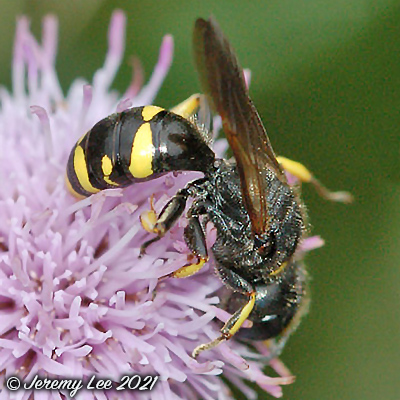
 |
|
Scientific Classifications explained » Amphibians » Ants » Aphids » Bees » Beetles » Birds » Bugs » Butterflies » Caterpillars » Damselflies » Dragonflies » Earwigs » Flies » Frog/Leafhoppers » Fungi » Galls » Grasshoppers » Harvestmen » Hoverflies » Lacewings » Ladybirds » Leaf Mines » Lichens » Mammals » Millipedes » Mosses » Moths » Sawflies » Slugs » Snails » Spiders » Trees & Shrubs » Wasps » Wild Flowers » Woodlice » Postboxes |
UK Nature > Wasps > Ectemnius continuus

Scientific Name: Ectemnius continuus Common Name: Digger Wasp Ectemnius continuus, more commonly known as a digger wasp, is one of several burrowing, usually solitary wasps of the family Sphecidae that excavate nests in soil which they provision with prey paralyzed by stinging for their larvae to feed on. Found in various habitats but perhaps most frequent where abundant supplies of dead wood and umbellifer flowers are available. Can often be seen on such flowers in summer, feeding on pollen. Can be found early May to late September, peaking in June, July and August. Widely distributed in Britain as far north as Fifeshire; it is one of the most common Ectemnius species, especially in the south. Ectemnius species are difficult to separate so care needs to be taken with identification. It has the familiar black and yellow colouring associated with this group. |
|

https://www.uknature.co.uk is a website dedicated to showing the immense diversity of UK nature and wildlife. Our vast range of habitats, from lowland arable to snow covered mountains, from storm-ravaged coastlines to peaceful inland freshwater lakes and rivers, from dry, sandy heaths to deciduous and coniferous forests, all these habitats contribute to the abundance of UK nature. We have wild birds in huge numbers either residing or visiting our shores (597 recorded species as at July 2013) and we must also not forget the humble back garden with its grass lawns, flower beds filled with nectar rich flowers, shrubs and trees, all designed to attract huge numbers of insects such as bees, moths, butterflies and hoverflies; and finally the small ponds which provide safe havens for frogs, toads, newts and even slow worms and grass snakes. www.uknature.co.uk is the showcase for my personal passion, photographing uknature in all its glory. I sincerely hope you all enjoy the fruits of my labours. This site and all images contained therein is © Jeremy Lee 2004 - 2025. All Rights Reserved. Site design by Jeremy Lee. Site development & IT Support by Stuart Lee. |